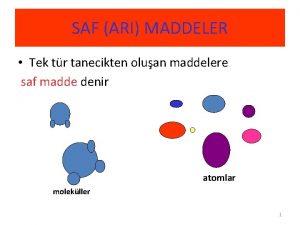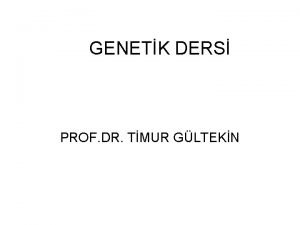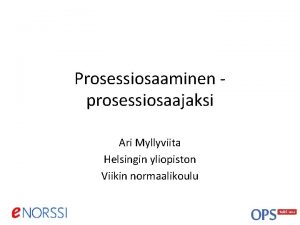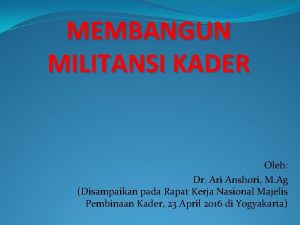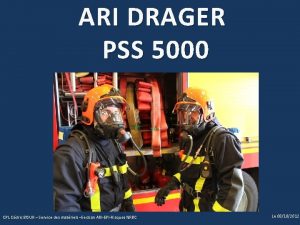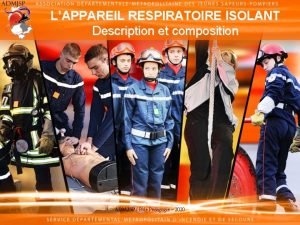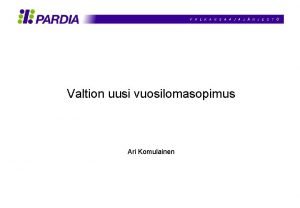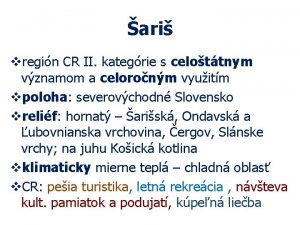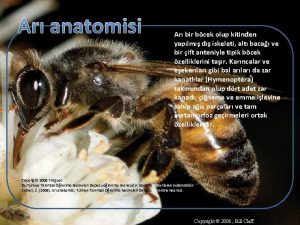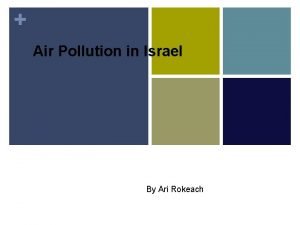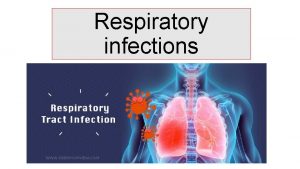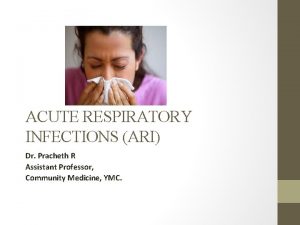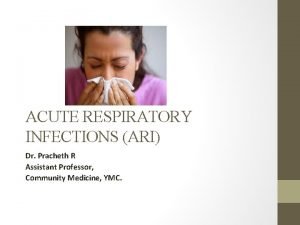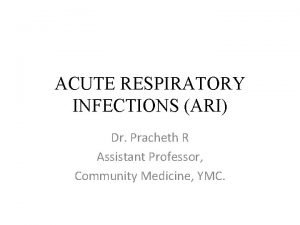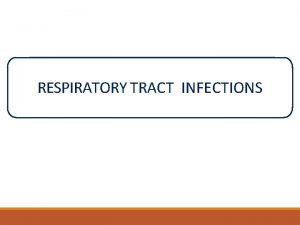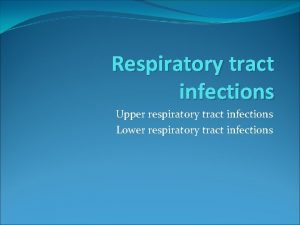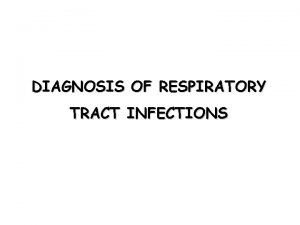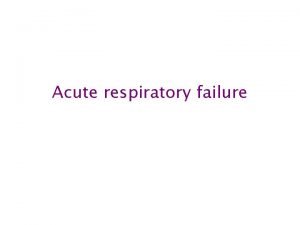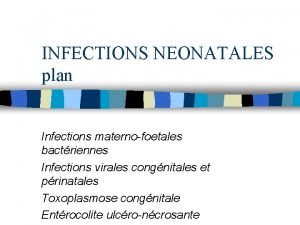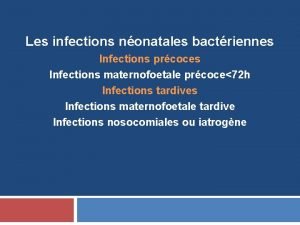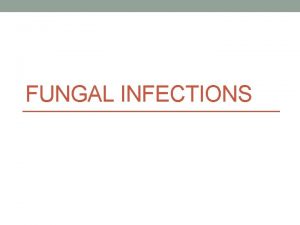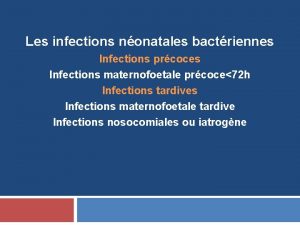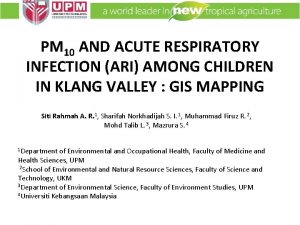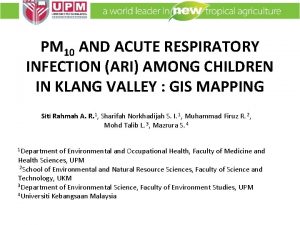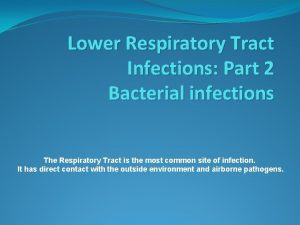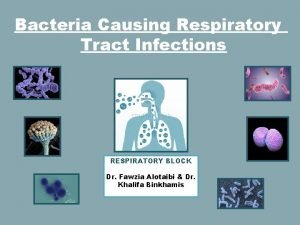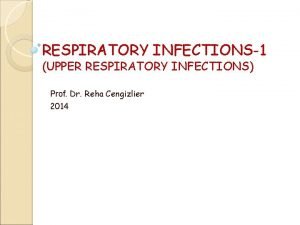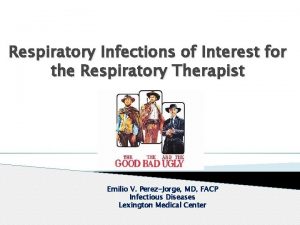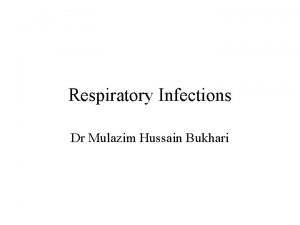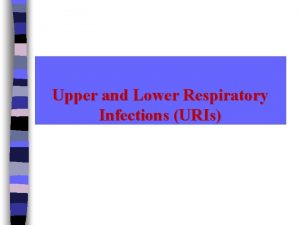ACUTE RESPIRATORY INFECTIONS ARI R GHASEMI MDMPH ACUTE


















































- Slides: 50


������ ������ ����� ACUTE RESPIRATORY INFECTIONS (ARI) R. GHASEMI MD-MPH




ACUTE RESPIRATORY INFECTIONS (ARI) ������� �� �� ����

ACUTE RESPIRATORY INFECTIONS (ARI) Comorbidity ���� �� ��������� ��������






ACUTE RESPIRATORY INFECTIONS (ARI) ANATOMIC CLASSIFICATION UPPER RESPIRATORY TRACT INFECTIONS PHARYNGITIS TOSILLITIS SINUSITIS OTITIS MEDIA

ACUTE RESPIRATORY INFECTIONS (ARI) MILD RESPIRATORY SYNDROMS LARYNGITIS TORACHOBRONCHITIS EPIGLOTITIS

ACUTE RESPIRATORY INFECTIONS (ARI) ACUTE LOWER RESPIRATORY INFECTIONS BRONCHIOLITIS PEUNOMONIA

ACUTE RESPIRATORY INFECTIONS (ARI) CLINICAL CLASSIFICATION NO FEVER, COUGH OR COLD

ACUTE RESPIRATORY INFECTIONS (ARI) PEUNOMONIA SEVERE PEUNOMONIA VERY SEVERE PEUNOMONIA




ACUTE RESPIRATORY INFECTIONS (ARI) EPIDEMIC SPORADIC

ACUTE RESPIRATORY INFECTIONS (ARI) EPIDEMIC SEASONAL INFLUENZA AVIAN INFLUENZA SWINE INFLUENZA SARS MERS-Co. V

SEASONAL INFLUENZA Seasonal Flu is a contagious respiratory illness caused by flu viruses. Typically starts in the fall and peaks in January or February. It spreads between people and can cause mild to severe illness. High risk groups including : those age 65 and older, children younger than 2, chronic health conditions.

INFLUENZA

Avian influenza A(H 5 N 1) and A(H 7 N 9) background The A(H 5 N 1) virus subtype, a highly pathogenic AI virus, first infected humans in 1997 during a poultry outbreak in Hong Kong SAR, China. Since its widespread reemergence in 2003 and 2004, this avian virus has spread from Asia to Europe and Africa and has become entrenched in poultry in some countries, resulting in millions of poultry infections, several hundred human cases, and many human deaths.

Avian influenza A(H 5 N 1) and A(H 7 N 9) The A(H 7 N 9) virus subtype, a low pathogenic AI virus, first infected 3 humans – 2 residents of the city of Shanghai and 1 resident of Anhui province - in March 2013. No cases of A(H 7 N 9) outside of China have been reported.

Avian influenza A(H 5 N 1) and A(H 7 N 9) Ongoing circulation of A(H 5 N 1) and A(H 7 N 9) viruses in poultry, especially where endemic, continues to pose threats to public health, as these viruses have both the potential to cause serious disease in people and may have the potential to change into a form that is more transmissible among humans.

Avian influenza A(H 5 N 1) and A(H 7 N 9) infections and clinical features in humans The case fatality rate for A(H 5 N 1) and A(H 7 N 9) virus infections in people is much higher compared to that of seasonal influenza infections. The A(H 7 N 9) virus particularly affects people with underlying medical conditions.

Avian influenza A(H 5 N 1) and A(H 7 N 9) The A(H 5 N 1) and A(H 7 N 9) AI viruses remain two of the influenza viruses with pandemic potential, because they continue to circulate widely in some poultry populations, most humans likely have no immunity to them, and they can cause severe disease and death in humans.

Avian Flu H 5 N 1 is a highly pathogenic avian (bird) flu virus that has caused serious outbreaks in domestic poultry in parts of Asia and the Middle Eeast. Highly pathogenic refers to the virus, s ability to produce disease. 650 cases in 15 countries since 2003

Swine Flu The H 1 N 1 flu virus caused a worldwide pandemic in 2009. It is now a human seasonal flu virus that also circulates in pigs 2014 is the first season since 2009 that H 1 N 1 has been so predominant in USA.

SARS China’s latest SARS outbreak has been contained, but biosafety concerns remain – Update 7 18 May 2004

Middle East respiratory syndrome coronavirus (MERS-Co. V) Between 12 and 16 October 2014, the National Focal Point for the Kingdom of Saudi Arabia (KSA) notified WHO of 5 additional cases of Middle East respiratory syndrome coronavirus (MERS-Co. V) infection, including 2 deaths

Middle East respiratory syndrome coronavirus (MERS-Co. V) It is caused by a coronavirus called MERS-Co. V. Most people who have been confirmed to have MERS-Co. V infection developed severe acute respiratory illness. They had fever, cough, and shortness of breath. About 30% of people confirmed to have MERSCo. V infection have died

Middle East respiratory syndrome coronavirus (MERS-Co. V) So far, all the cases have been linked to countries in and near the Persian Golf. This virus has spread from ill people to others through close contact, such as caring for or living with an infected person. However, there is no evidence of sustained spreading in community settings

Middle East respiratory syndrome coronavirus (MERS-Co. V)

Middle East respiratory syndrome coronavirus (MERS-Co. V) Countries with Lab-Confirmed MERS Cases Countries in or near the Persian Golf with Cases Saudi Arabia United Arab Emirates (UAE) Qatar Oman Jordan Kuwait Yemen Lebanon Iran

Middle East respiratory syndrome coronavirus (MERS-Co. V) Countries with Travel-associated Cases United Kingdom (UK) France Tunisia Italy Malaysia Philippines Greece

Middle East respiratory syndrome coronavirus (MERS-Co. V) Countries with Travel-associated Cases Egypt United States of America (USA) Netherlands Algeria Austria Turkey Two patients were transferred to Germany for care

Middle East respiratory syndrome coronavirus (MERS-Co. V) CLUSTERS OF RESPIRATORY ILLNESS IN WHICH MERS-COV INFECTION SHOULD BE CONSIDERED CLUSTERS OF PATIENTS WITH SEVERE ACUTE RESPIRATORY ILLNESS (E. G. , FEVER AND PNEUMONIA REQUIRING HOSPITALIZATION)

Middle East respiratory syndrome coronavirus (MERS-Co. V) WITHOUT RECOGNIZED LINKS TO A CASE OF MERSCOV INFECTION OR TO TRAVELERS FROM COUNTRIES IN OR NEAR THE PERSIAN GOLF SHOULD BE EVALUATED FOR COMMON RESPIRATORY PATHOGENS.

Middle East respiratory syndrome coronavirus (MERS-Co. V) IF THE ILLNESSES REMAIN UNEXPLAINED, PROVIDERS SHOULD CONSIDER TESTING FOR MERS-COV, IN CONSULTATION WITH STATE AND LOCAL HEALTH DEPARTMENTS.

Background What is Middle East respiratory syndrome (MERS)? • MERS is a coronavirus (named for the crown-like – projections on the virus surface). – Coronaviruses are very common and usually cause – colds and mild upper respiratory infections but can – also cause severe illness like the 2003 SARS-Co. V. – MERS is related to but is not the same as SARS. – First identified– late 2012 in Saudi Arabia – April 30, 2014 MERS virus - Image from CDC. gov 2

Location of Cases Saudi Arabia. No cases in the United States to thispoint. • April 30, 2014


Other Countries Reporting Cases , . / ck. f April 30, 2014

April 24, 2014



 Tero ejemplos
Tero ejemplos Acute gingival infections
Acute gingival infections Dr maryam ghasemi
Dr maryam ghasemi Respiratory zone of the respiratory system
Respiratory zone of the respiratory system Protective reflexes
Protective reflexes Bacterial vaginosis
Bacterial vaginosis Genital infections
Genital infections Opportunistic infections
Opportunistic infections Storch infections
Storch infections Amber blumling
Amber blumling Chapter 25 sexually transmitted infections and hiv/aids
Chapter 25 sexually transmitted infections and hiv/aids Bone and joint infections
Bone and joint infections Postpartum infections
Postpartum infections Opportunistic infections
Opportunistic infections Phagocytr
Phagocytr Understanding the mirai botnet
Understanding the mirai botnet Cryptosporidiose
Cryptosporidiose Retroviruses and opportunistic infections
Retroviruses and opportunistic infections Can methotrexate cause yeast infections
Can methotrexate cause yeast infections Storch infections
Storch infections Ari edwald
Ari edwald Namumuno sa rebelyong taiping
Namumuno sa rebelyong taiping Ari rusila
Ari rusila Ari kuusio
Ari kuusio Saf arı maddeler
Saf arı maddeler Vesulahti
Vesulahti Andian ari anggraeni
Andian ari anggraeni Spermatogenez y gonozomu
Spermatogenez y gonozomu Prosessiosaaja
Prosessiosaaja Ari okkonen
Ari okkonen Ari lehtinen coxa
Ari lehtinen coxa Ari ball
Ari ball Ari anshori
Ari anshori Ari drager
Ari drager Antikolinergi
Antikolinergi Polvijärvi hammaslääkäri
Polvijärvi hammaslääkäri Oración con la palabra ara
Oración con la palabra ara Prudent investment fund
Prudent investment fund Micro régulateur ari
Micro régulateur ari Valtion vuosilomasopimus
Valtion vuosilomasopimus Ari aranda
Ari aranda Ari sarviharju
Ari sarviharju Ari kouvonen
Ari kouvonen Ari koskelainen
Ari koskelainen Ari brodach
Ari brodach Ari requicha
Ari requicha Arı anatomisi
Arı anatomisi Ngumbah awak disebut
Ngumbah awak disebut Ari rokeach
Ari rokeach Ari kovaninda n kromozomlu
Ari kovaninda n kromozomlu Ari jain
Ari jain
























